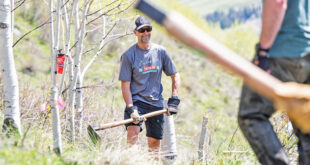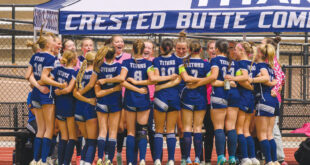Team Salomon/Crested Butte found itself faced with an entirely new beast in the world of adventure racing: camels.
The team, consisting of Jari Kirkland, Bryan Wickenhauser, Eric Sullivan and Dave Mackey, headed to Abu Dhabi in the United Arab Emirates to compete in the Abu Dhabi Adventure Challenge December 9-14.
It was the first race of its kind in Abu Dhabi and had a $200,000 cash purse up for grabs, thus attracting the elite adventure racing teams from around the world.
The race opened with two days of sea kayaking in the Persian Gulf in two-person kayaks complete with masts and sails.
Unfortunately, the sails were of no use as teams encountered two days of sustained headwinds and waves along the 120-kilometer section.
“The big mental bummer was that the entire paddling section was in a constant headwind,” explains Wickenhauser.
“It was pretty intense,” adds Kirkland. “There were waves crashing over the front of the boat hitting me in the chest.”
To make matters worse, the headwind left little opportunity for the team to eat during the two 10-hour days of paddling.
“It was just so hard to eat right when you’re paddling in a headwind because when you’re eating, you’re not paddling,” says Wickenhauser. “If you stop paddling you pretty much stop.”
After two days the team was in 10th place, somewhat discouraged but far from demoralized at their standing.
“We were reasonably happy with 10th place but we knew we had some time to make up,” says Wickenhauser.
From there teams were transported to the Liwa Oasis and then driven two kilometers into the Rub al Khali, or Empty Quarter, for an overnight stay of unprecedented style before the next two days of desert trekking.
Race organizers had 10 large canvas tents flush with Persian rugs and plush pillows, set up with traditional Middle Eastern foods to feast upon.
“It was like the Secret Stash or a hookah lounge,” says Wickenhauser. “There were water pipes everywhere. It made the experience so pleasant. They did it right.”
After an evening of food, relaxation and music, teams headed out on a two-day, 84-kilometer trek through a series of sand dunes under the oppressive Middle Eastern sun. Teams were relegated to a certain amount of water between checkpoints with no shade in sight. Temperatures reached the mid to high 90s and the first day proved to be a hydrating nightmare.
“You had about 90 ounces of water per three hours,” explains Wickenhauser. “There was nowhere to hide from the direct sun.”
Furthermore, the sand offered little to no support underfoot.
“The dunes were impressive,” says Wickenhauser. “Basically, you’re trekking from Western State College to the top of Signal Peak and back down. There’s no support underneath the sand. You’re post-holing in sand for 12 hours. It’s one step forward, two steps back.”
Wickenhauser explained that he became so dehydrated it wasn’t until that evening that he had his first bathroom break.
“If you’re not peeing, you’re not drinking enough,” says Wickenhauser.
“I’ve never been so happy in my life that the sun set at 5:30 p.m.,” says Kirkland.
In an effort to reduce weight, the team brought just one two-person tent with them for the desert overnight and ended up stuffing themselves inside it for one long night.
“We just took the poles out and made it into a bivy,” says Kirkland. “It was the worst night of sleep ever.”
For day two in the desert, each team was given a camel to carry gear, and that was when the desert nightmare really started.
Race organizers gave the competitors a brief introduction into camel management, explaining that the camels know the best way through the dunes and the team should just follow the camels’ lead.
Teams were staggered at the start and almost the entire field watched one team immediately crumble at the mercy of their stubborn beast of burden on the first dune.
“The first team goes off and lets go of the reins and the camel takes off,” explains Wickenhauser. “It was just running around.”
According to Wickenhauser, Team Salomon/Crested Butte had “a reasonably decent camel,” yet still encountered trouble on the dunes.
“The camel wanted to take the lowest angle,” explains Wickenhauser. “We got 200 feet from the top of the first dune and the camel proceeds to lay down.”
“I’m surprised I’m not in a jail in Abu Dhabi for killing a camel,” says Kirkland.
While Team Salomon/Crested Butte eventually managed to rally their animal through the rest of the day, other teams were stuck with their beasts in the midday sun.
“There were teams that literally sat in the hot sun because their camel would not get up,” says Kirkland.
Wickenhauser estimates that Team Salomon/Crested Butte moved into third or fourth place by the end of the day, only to have race organizers decide to eliminate the day from the overall standings because so many teams had so much trouble.
“Our good fortune didn’t pay dividends,” says Wickenhauser.
“Twelve hours in the desert with a camel and none of it counted,” adds Kirkland. “It’s a little disconcerting.”
As a result, Team Salomon/Crested Butte found themselves in seventh place with two days left in the race.
The plan was to make up more time in the 90-kilometer ride the next day until they were hit with another blow by the race organizers.
“We were psyched,” says Wickenhauser. “Then they shortened the day from 90 kilometers to 54 kilometers. We couldn’t use the bike day to make up time because it was only three hours long.”
The team finished ninth on the day to hold their seventh place overall standing with one day of mountain trekking and ropes work left to go to the finish line.
Teams were bussed once more to sleep in grass in the shadow of “the only mountain in the UAE. It looked like a razorback mountain made of limestone,” says Wickenhauser.
The 24-kilometer mountain trek provided ample challenge for competitors as they worked their way up, down and across the razor-sharp rock as fast as possible. Sometimes running, sometimes scrambling on all fours and then several sections of climbing clipped in to fixed ropes.
Race organizers marked the course with spray-painted dots, yet teams were still required to use orienteering skills to reach mandatory checkpoints.
After reaching the eighth checkpoint, Team Salomon/Crested Butte crested the razorback ridge with a 12-minute gap on the eighth place team, only to make a wrong turn and follow the dots down the wrong side of the ridge, ending up at the tenth checkpoint.
“We were just constantly in dot mode,” explains Wickenhauser. “We turned right instead of left and missed checkpoint nine.”
As a result, they had to climb back over the ridge to make the ninth checkpoint before returning back on course toward the final 600-foot climb and rappel portion of the trek.
The mistake cost them one place as they came in off the final 20-kilometer road ride and five-kilometer run to the finish line in eighth place—winning $7,500 of the $200,000 cash purse.
While the stage race format of the event offered teams rest at night, sometimes in palatial tents complete with showers and bathrooms, Wickenhauser found the race to be as difficult as any race Team Salomon/Crested Butte had encountered.
“It was just as tough as anything we’d ever done,” says Wickenhauser. “It’s a different scenario when you’re dealing with heat and sand.”
The team now turns to the snow as they begin their assault, as individuals, on the 2007-2008 randonnee ski race circuit in an effort to earn a spot on the US Ski Mountaineering team headed to the Ski Mountaineering World Championships in Switzerland in February.
 The Crested Butte News Serving the Gunnison Valley since 1999
The Crested Butte News Serving the Gunnison Valley since 1999


